Using the road (159 to 203)
Rules 159 to 203 of the Northern Ireland Highway Code.
General rules
159
Before moving off you should:
- use all mirrors to check the road is clear
- look round to check the blind spots (the areas you are unable to see in the mirrors)
- signal if necessary before moving out
- look round for a final check
Move off only when it is safe to do so.
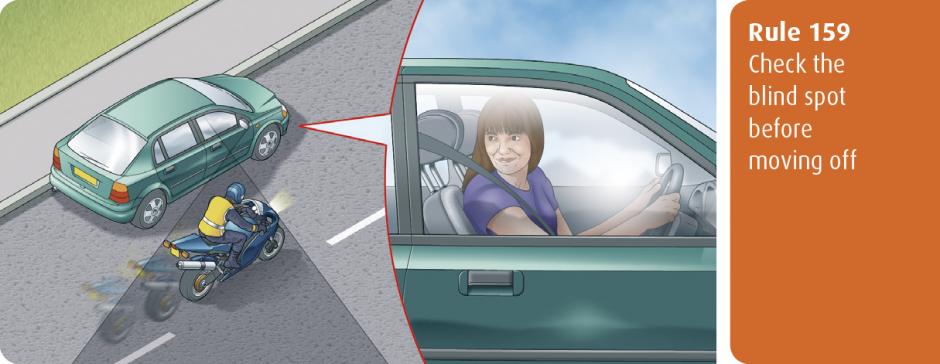
160
Once moving you should:
- keep to the left, unless road signs or markings suggest differently - the exceptions are when you want to overtake, turn right or pass parked vehicles or pedestrians in the road
- keep well to the left on right-hand bends, this will improve your view of the road and help avoid the risk of colliding with traffic approaching from the opposite direction
- drive or ride with both hands on the wheel or handlebars, where possible, this will help you to remain in full control of the vehicle at all times
- be aware of other vehicles especially cycles and motorcycles that may be filtering through traffic, these are more difficult to see than larger vehicles and their riders are particularly vulnerable, so give them plenty of room especially if you are driving a long vehicle or towing a trailer
- select a lower gear before you reach a long downhill slope, this will help to control your speed
- when towing, remember the extra length will affect overtaking and manoeuvring, and the extra weight will also affect braking and acceleration
161. Mirrors
All mirrors should be used effectively throughout your journey. You should:
- use your mirrors frequently so that you always know what is behind and to each side of you
- use them in good time before you signal or change direction or speed
- be aware that mirrors do not cover all areas and that there will be blind spots - you will need to look round and check
Remember: mirrors–signal–manoeuvre
Overtaking
162
Before overtaking you should make sure:
- the road is sufficiently clear ahead
- road users are not beginning to overtake you
- there is a suitable gap in front of the road user you plan to overtake
163
Overtake only when it is safe and legal to do so. You should:
- not get too close to the vehicle you intend to overtake
- use your mirrors, signal when it is safe to do so, take a quick sideways glance if necessary into the blind spot area and then start to move out
- not assume you can simply follow a vehicle ahead which is overtaking; there may only be enough room for one vehicle
- move quickly past the vehicle you are overtaking, once you have started to overtake, allow plenty of room and move back to the left as soon as you can - but do not cut in
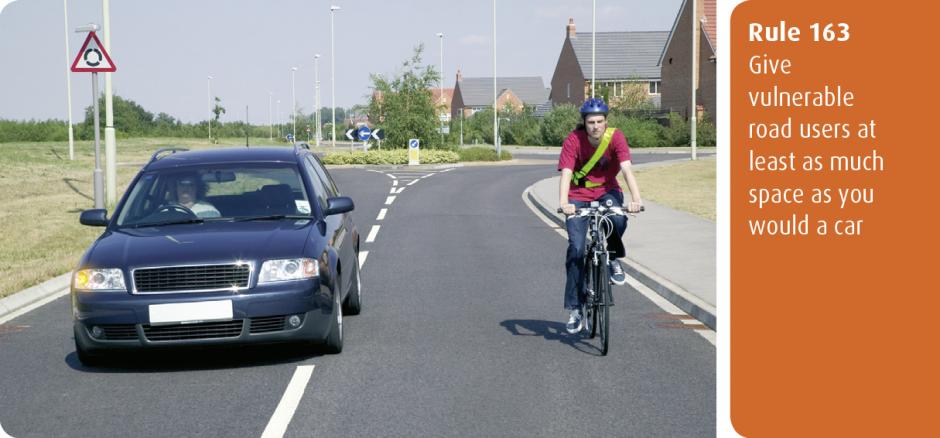
- take extra care at night and in poor visibility when it is harder to judge speed and distance
- give way to oncoming vehicles before passing parked vehicles or other obstructions on your side of the road
- only overtake on the left if the vehicle in front is signalling to turn right, and there is room to do so
- stay in your lane if traffic is moving slowly in queues - if the queue on your right is moving more slowly than you are, you may pass on the left
- give motorcyclists, cyclists and horse riders at least as much room as you would when overtaking a car (see rules 211–215)
Remember: mirrors–signal–manoeuvre
164. Large vehicles
Overtaking these is more difficult. You should:
- drop back as this will increase your ability to see ahead and should allow the drivers of large vehicles to see you in their mirrors (getting too close to large vehicles, including agricultural vehicles such as a tractor with a trailer or other fixed equipment, will obscure your view of the road ahead and there may be another slow moving vehicle in front)
- make sure that you have enough room to complete your overtaking manoeuvre before committing yourself - it takes longer to pass a large vehicle, if in doubt do not overtake
- not assume you can follow a vehicle ahead which is overtaking a long vehicle - if a problem develops, they may abort overtaking and pull back in
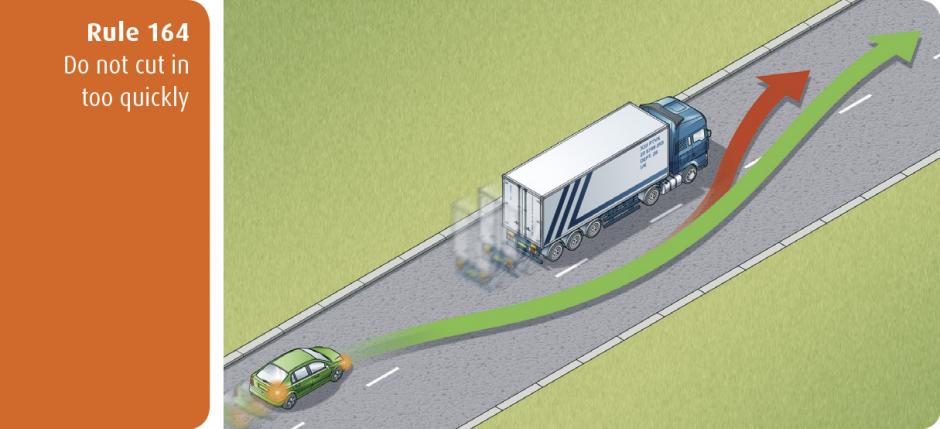
165
You must not overtake:
- if you have to cross or straddle double white lines with a solid line nearest to you (but see rule 129)
- if you would have to enter an area designed to divide traffic, if it is surrounded by a solid white line
- the nearest vehicle to a signal-controlled crossing facility, especially when it has stopped to let pedestrians, equestrian traffic or cyclists to cross
- if you would have to enter a lane reserved for buses, trams or cycles during its hours of operation
- after a ‘No Overtaking’ sign and until you pass a sign cancelling the restriction
Laws RTO 1995 Art 50, TSR regs 8, 25 & 25B, RTRO Art 59(4) & PCR reg 20
166
Do not overtake if there is any doubt, or where you cannot see far enough ahead to be sure it is safe. For example, when you are approaching:
- a corner or a bend
- a hump bridge
- the brow of a hill
167
Do not overtake where you might come into conflict with other road users. For example:
- approaching or at a road junction on either side of the road
- where the road narrows
- when approaching a school crossing patrol
- between a kerb and a bus or tram when it is at a stop
- where traffic is queuing at junctions or road works
- when you would force another road user to swerve or slow down
- at a level crossing
- when a road user is indicating right, even if you believe the signal should have been cancelled - do not take a risk; wait for the signal to be cancelled
- stay behind if you are following a cyclist approaching a roundabout or junction, and you intend to turn left
- when a tram is standing at a kerbside tram stop and there is no clearly marked passing lane for other traffic
168. Being overtaken
If a driver is trying to overtake you, maintain a steady course and speed, slowing down if necessary to let the vehicle pass. Never obstruct drivers who wish to pass. Speeding up or driving unpredictably when someone is overtaking you is dangerous.
Drop back to maintain a two-second gap if someone overtakes and pulls into the gap in front of you.
169
Do not hold up a long queue of traffic, especially if you are driving a large or slow-moving vehicle. Check your mirrors frequently, and if necessary, pull in where it is safe and let traffic pass.
Road junctions
170
Take extra care at junctions. You should:
- watch out for cyclists, motorcyclists, powered wheelchairs/mobility scooters and pedestrians as they are not always easy to see - be aware that they may not have seen or heard you if you are approaching from behind
- watch out for pedestrians crossing a road into which you are turning - if they have started to cross they have priority, so give way
- watch out for long vehicles which may be turning at a junction ahead; they may have to use the whole width of the road to make the turn (see rule 221)
- Road users requiring extra care (204 to 225)
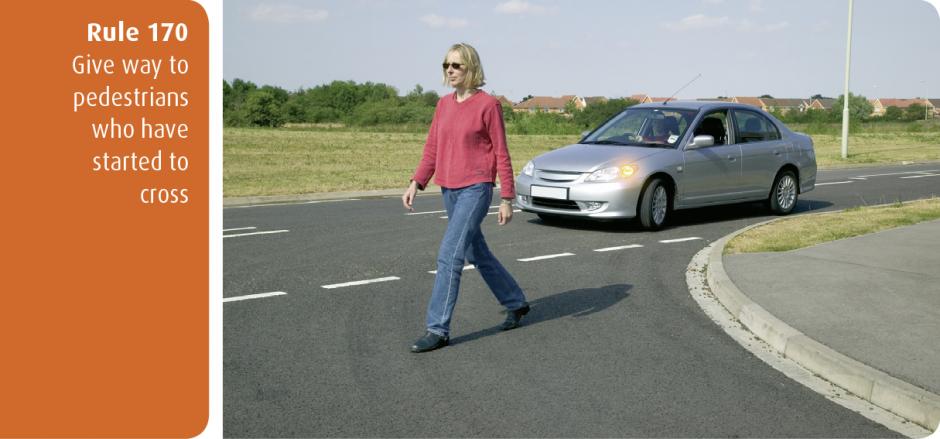
- watch out for horse riders who may take a different line on the road from that which you would expect
- not assume, when waiting at a junction, that a vehicle coming from the right and signalling left will actually turn - wait and make sure
- look all around before emerging, do not cross or join a road until there is a gap large enough for you to do so safely
171
You must stop behind a line at a junction with a ‘Stop’ sign and a solid white line across the road. Wait for a safe gap in the traffic before you move off.
Laws RTO 1995 Art 50 and TSR regs 8 & 14
172
The approach to a junction may have a ‘Give Way’ sign or a triangle marked on the road. You must give way to traffic on the main road when emerging from a junction with broken white lines across the road.
Laws RTO 1995 Art 50 & TSR regs 8, 14 & 24
173. Dual carriageways
When crossing, or turning right, first assess whether the central reservation is deep enough to protect the full length of your vehicle:
- if it is, then you should treat each half of the carriageway as a separate road and wait in the central reservation until there is a safe gap in the traffic on the second half of the road
- if the central reservation is too shallow for the length of your vehicle, wait until you can cross both carriageways in one go
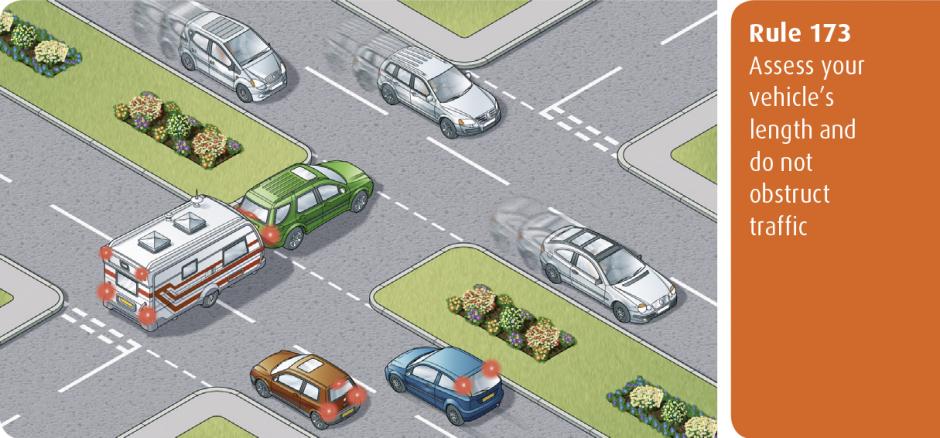
174. Box junctions
These have criss-cross yellow lines painted on the road (see 'Road markings'). You must not enter the box until your exit road or lane is clear.
However, you may enter the box and wait when you want to turn right, and are only stopped from doing so by oncoming traffic, or by other vehicles waiting to turn right.
At signalled roundabouts you must not enter the box unless you can cross over it completely without stopping.
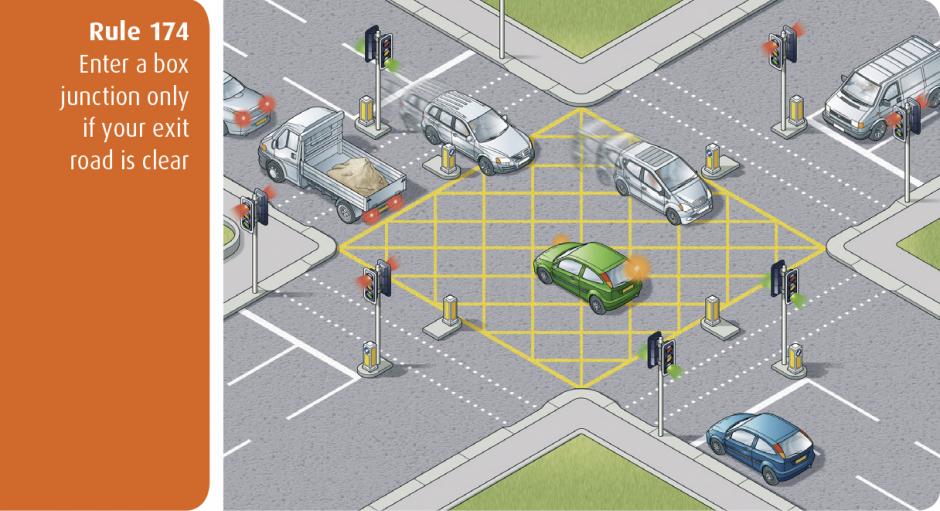
Laws RTO 1995 Art 50 & TSR regs 8 & 26
Junctions controlled by traffic lights
175
You must stop behind the white ‘Stop’ line across your side of the road unless the light is green. If the amber light appears you may go on only if you have already crossed the stop line or are so close to it that to stop might cause a collision.
Laws RTO 1995 Art 50 & TSR regs 8 & 33
176
You must not move forward over the white line when the red light is showing. Only go forward when the traffic lights are green if there is room for you to clear the junction safely or you are taking up a position to turn right.
If the traffic lights are not working, treat the situation as you would an unmarked junction and proceed with great care.
Laws RTO 1995 Art 50 & TSR regs 8 & 33
177. Green filter arrow
This indicates a filter lane only.
Do not enter that lane unless you want to go in the direction of the arrow. You may proceed in the direction of the green arrow when it, or the full green light, shows.
Give other traffic, especially cyclists, time and room to move into the correct lane.
178. Advanced stop lines
Some signal-controlled junctions have advanced stop lines to allow cycles to be positioned ahead of other traffic.
Motorists, including motorcyclists, must stop at the first white line reached, and should avoid blocking the way or encroaching on the marked area at other times, such as for example, if the junction ahead is blocked.
If your vehicle has proceeded over the first white line at the time that the signal goes red, you must stop at the second white line, even if your vehicle is in the marked area.
Allow cyclists time and space to move off when the green signal shows.
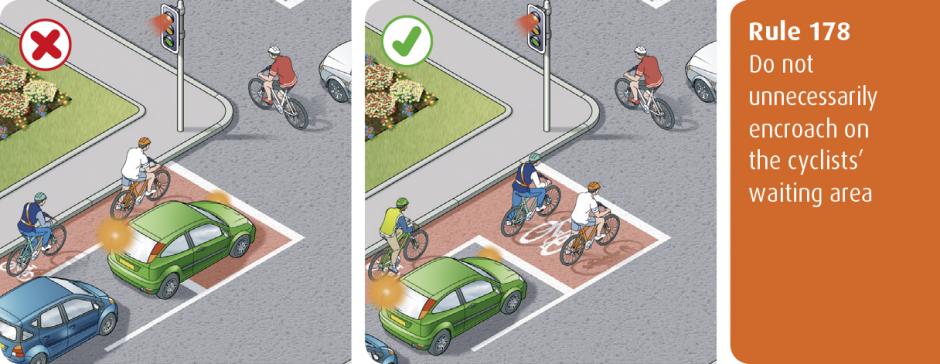
Laws RTO 1995 Art 50(1) & TSR reg 33(6)
Turning right
179
Well before you turn right you should:
- use your mirrors to make sure you know the position and movement of traffic behind you
- give a right-turn signal
- take up a position just left of the middle of the road or in the space for traffic turning right
- leave room for other vehicles to pass on the left, if possible
180
Wait until there is a safe gap between you and any oncoming vehicle. Watch out for cyclists, motorcyclists, pedestrians and other road users. Check your mirrors and blind spots again to make sure you are not being overtaken, then make the turn.
Do not cut the corner. Take great care when turning into a main road; you will need to watch for traffic in both directions and wait for a safe gap.
Remember: mirrors–signal–manoeuvre
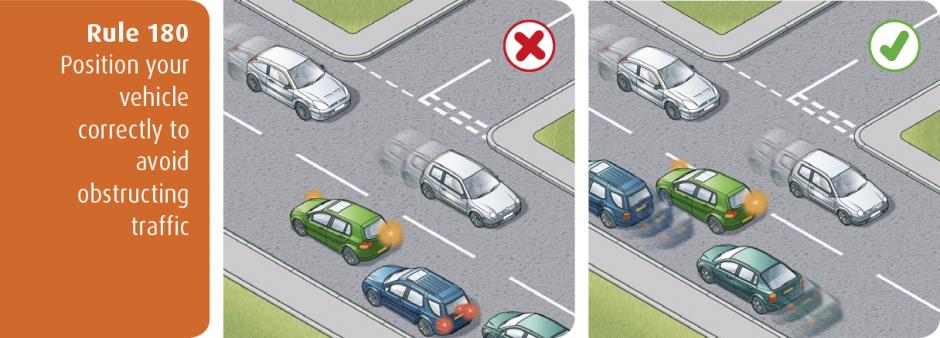
181
When turning right at a cross roads where an oncoming vehicle is also turning right, there is a choice of two methods:
- turn right side to right side; keep the other vehicle on your right and turn behind it - this is generally the safer method as you have a clear view of any approaching traffic when completing your turn
- left side to left side, turning in front of each other - this can block your view of oncoming vehicles, so take extra care (cyclists and motorcyclists in particular may be hidden from your view)
Road layout, markings or how the other vehicle is positioned can determine which course should be taken.
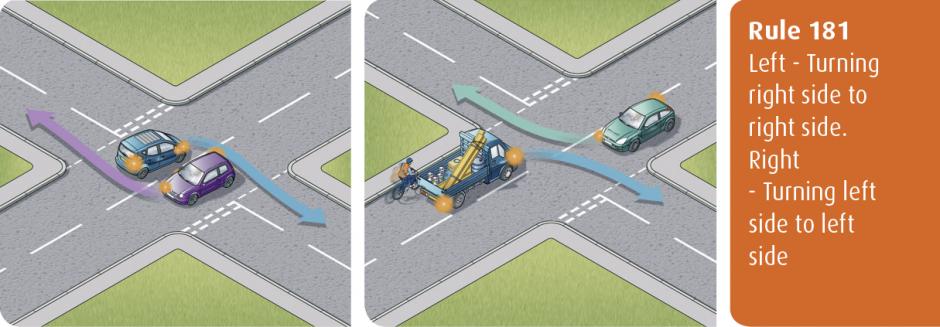
Turning left
182
Use your mirrors and give a left-turn signal well before you turn left. Do not overtake just as you turn left and watch out for traffic coming up on your left before you make the turn, especially if driving a large vehicle.
Cyclists and motorcyclists in particular may be hidden from your view.
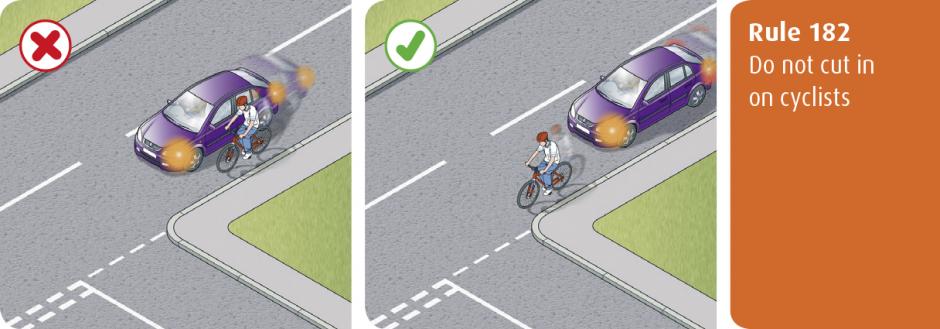
183
When turning:
- keep as close to the left as is safe and practicable
- give way to any vehicles using a bus lane, cycle lane or tramway from either direction
Roundabouts
184
On approaching a roundabout take notice and act on all the information available to you, including traffic signs, traffic lights and lane markings which direct you into the correct lane. You should:
- use mirrors – signal – manoeuvre at all stages
- decide as early as possible which exit you need to take
- give an appropriate signal (see rule 186)
- time your signals so as not to confuse other road users
- get into the correct lane
- adjust your speed and position to fit in with traffic conditions
- be aware of the speed and position of all the road users around you
185
When reaching the roundabout you should:
- give priority to traffic approaching from your right unless directed otherwise by signs, road markings or traffic lights
- check whether road markings allow you to enter the roundabout without giving way - if so, proceed, but still look to the right before joining
- watch out for all other road users already on the roundabout; be aware they may not be signalling correctly or at all
- look forward before moving off to make sure traffic in front has moved off
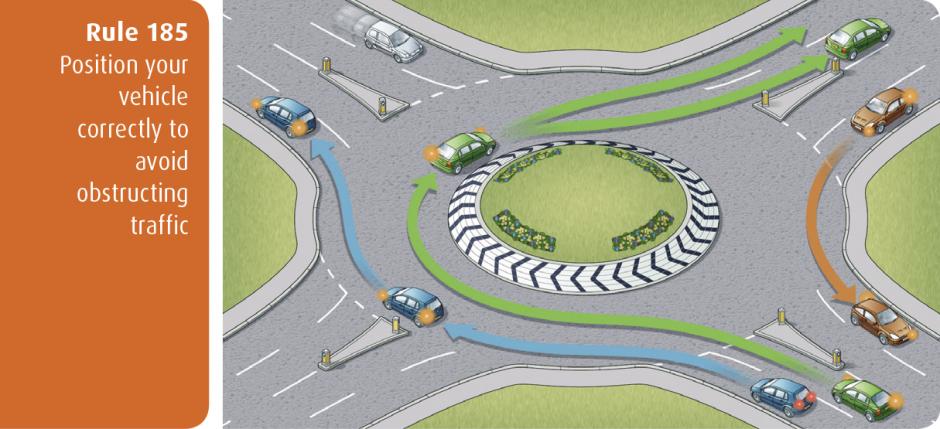
186. Signals and position
When taking the first exit to the left, unless signs or markings indicate otherwise:
- signal left and approach in the left hand lane
- keep to the left on the roundabout and continue signalling left to leave
When taking an exit to the right or going full circle, unless signs or markings indicate otherwise:
- signal right and approach in the right-hand lane
- keep to the right on the roundabout until you need to change lanes to exit the roundabout
- signal left after you have passed the exit before the one you want
When taking any intermediate exit, unless signs or markings indicate otherwise:
- select the appropriate lane on approach to the roundabout
- you should not normally need to signal on approach
- stay in this lane until you need to alter course to exit the roundabout
- signal left after you have passed the exit before the one you want
When there are more than three lanes at the entrance to a roundabout, use the most appropriate lane on approach and through it.
For more specific advice on procedures at roundabouts, see Appendix.
187
In all cases watch out for and give plenty of room to:
- pedestrians who may be crossing the approach and exit roads
- traffic crossing in front of you on the roundabout, especially vehicles intending to leave by the next exit
- traffic which may be straddling lanes or positioned incorrectly
- motorcyclists
- cyclists and horse riders who may stay in the left-hand lane and signal right if they intend to continue around the roundabout (allow them to do so)
- long vehicles (including those towing trailers) as these might have to take a different course or straddle lanes either approaching or on the roundabout because of their length - watch out for their signals
188. Mini-roundabouts
Approach these in the same way as normal roundabouts.
All vehicles must pass round the central markings except large vehicles which are physically incapable of doing so. Remember, there is less space to manoeuvre and less time to signal.
- avoid making U-turns at mini-roundabouts
- beware of others doing this
Laws RTO 1995 Art 50 & TSR regs 8 & 14
189
At double mini-roundabouts treat each roundabout separately and give way to traffic from the right.
190. Multiple roundabouts
At some complex junctions there may be a series of mini-roundabouts at each intersection. Treat each mini-roundabout separately and follow the normal rules.
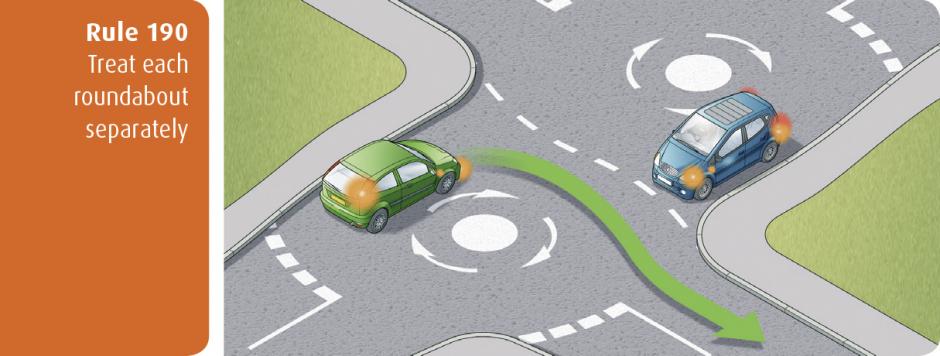
Pedestrian crossings
191
- you must not park on a crossing or in the area covered by the zig-zag lines
- you must not overtake the moving vehicle nearest the crossing or the vehicle nearest the crossing which has stopped to give way to pedestrians
Law RTRO Art 59(4) & PCR regs 16, 18 & 20
192
In queuing traffic, you should keep the crossing clear.
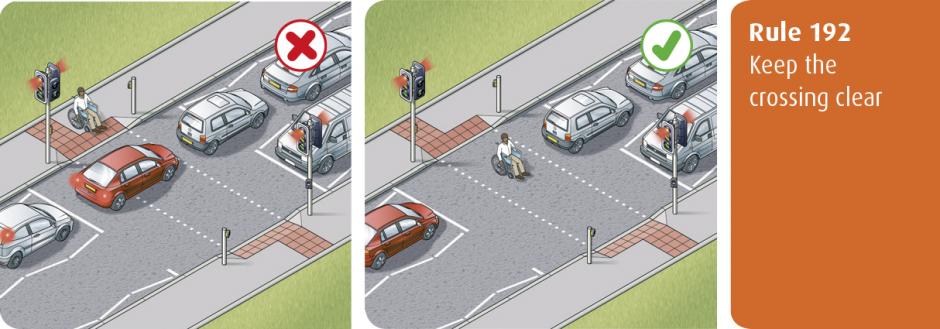
193
You should take extra care where the view of either side of the crossing is blocked by queuing traffic or incorrectly parked vehicles. Pedestrians may be crossing between stationary vehicles.
194
Allow pedestrians plenty of time to cross and do not harass them by revving your engine or edging forward.
195. Zebra crossings
As you approach a zebra crossing:
- look out for people waiting to cross and be ready to slow down or stop to let them cross
- you must give way when a pedestrian has moved onto a crossing
- allow more time for stopping on wet or icy roads
- do not wave or use your horn to invite pedestrians across; this could be dangerous if another vehicle is approaching
- be aware of pedestrians approaching from the side of the crossing
A zebra crossing with a central island is two separate crossings (see rule 20).
Laws RTRO Art 59(4) & PCR reg 21
Signal-controlled crossings
196. Pelican crossings
These are signal-controlled crossings where flashing amber follows the red ‘Stop’ light:
- you must stop when the red light shows
- when the amber light is flashing, you must give way to any pedestrians on the crossing
- if the amber light is flashing and there are no pedestrians on the crossing, you may proceed with caution
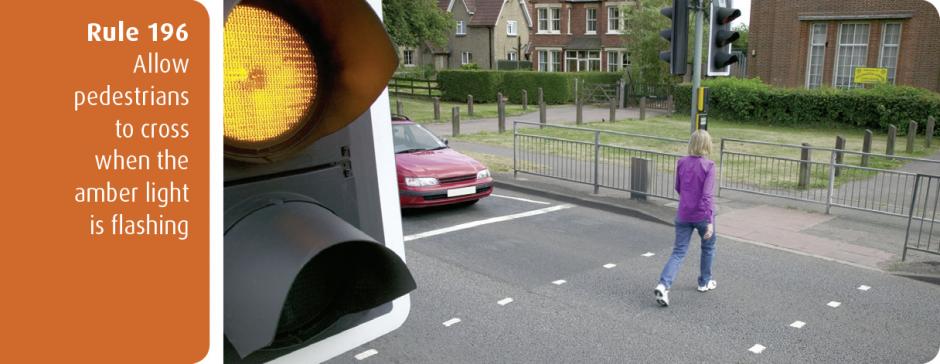
Laws RTRO Art 59(4) & PCR regs 10, 19 & 22
197
Pelican crossings which go straight across the road are one crossing, even when there is a central island. You must wait for pedestrians who are crossing from the other side of the island.
Laws RTRO Art 59(4) & PCR reg 22
198
Give way to anyone still crossing after the signal for vehicles has changed to green. This advice applies to all crossings.
199. Toucan, puffin and equestrian crossings
These are similar to pelican crossings, but there is no flashing amber phase; the light sequence for traffic at these three crossings is the same as at traffic lights.
If the signal-controlled crossing is not working, proceed with extreme caution.
Reversing
200
Choose an appropriate place to manoeuvre. If you need to turn your vehicle around, wait until you find a safe place. Try not to reverse or turn around in a busy road; find a quiet side road or drive round a block of side streets.
201
Do not reverse from a side road into a main road. When using a driveway, reverse in and drive out if you can.
202
Look carefully before you start reversing. You should:
- use all your mirrors
- check any ‘blind spot’ behind you (the part of the road you cannot see easily in the mirrors)
- check there are no pedestrians (particularly children), cyclists, other road users or obstructions in the road behind you
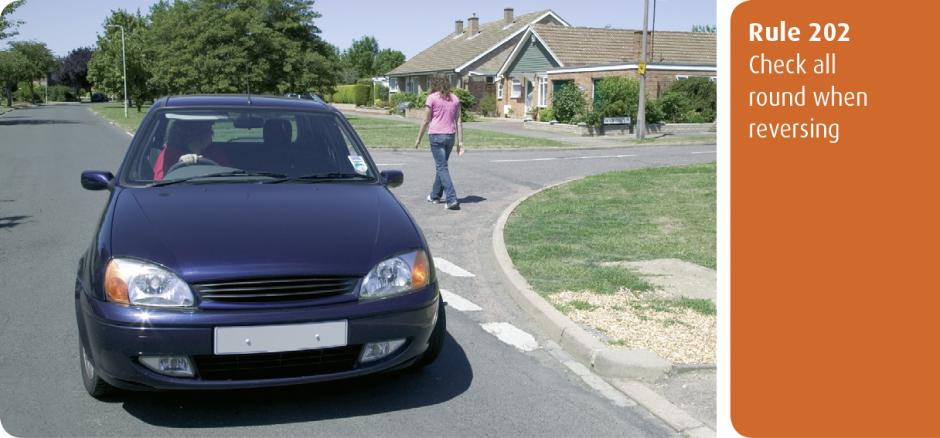
Reverse slowly while:
- checking all around
- looking mainly through the rear window
- being aware that the front of your vehicle will swing out as you turn
Get someone to guide you if you cannot see clearly.
203
You must not reverse your vehicle further than necessary.
Law CUR reg 122